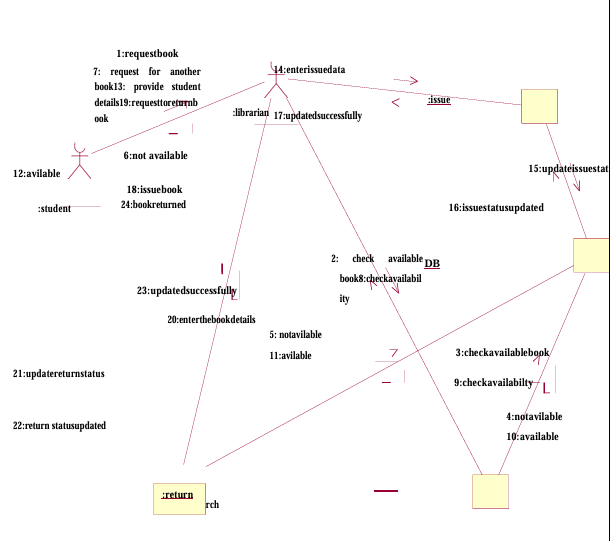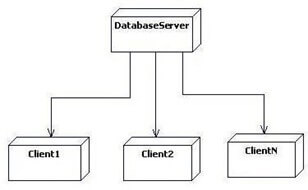Book Bank System
Aim: To create a system to perform book bank operation
Procedure :(I) problem statement:
A Book Bank lends books and magazines to member, who is registered in the system. Also it handles the purchase of new titles for the Book Bank. Popular titles are brought into multiple copies. Old books and magazines are removed when they are out or date or poor in condition. A member can reserve a book or magazine that is not currently available in the book bank, so that when it is returned or purchased by the book bank, that person is notified. The book bank can easily create, replace and delete information about the tiles, members, loans and reservations from the system.
ii)Software Requirements Specification
Introduction:
Book Bank is the interface between the students and Librarian. It aims at improving the efficiency in the Issue of books or magazines and reduces the complexities involved in it to the maximum possible extent.
Purpose
If the entire process of ‘Issue of Books or Magazines’ is done in a manual manner then it would take several months for the books or magazines to reach the applicant. Considering the fact that the number of students for Book Bank is increasing every year, an Automated System becomes essential to meet the demand. So this system uses several programming and database techniques to elucidate the work involved in this process. The system has been carefully verified and validated in order to satisfy it.
Scope
The System provides an online interface to the user where they can fill in their personal details and submit the necessary documents (may be by scanning). The authority concerned with the issue of books can use this system to reduce his workload and process the application in a speedy manner.
Definitions, Acronyms and the Abbreviations
- Librarian –Refers to the super user who is the Central Authority who has been vested with the privilege to manage the entire system.
- Student-One who wishes to obtain the Books or
- HTML –Markup Language used for creating web
- J2EE-Java2EnterpriseEdition is a programming platform and it is the part of the java platform for developing and running distributed java applications.
- HTTP-Hyper Text Transfer Protocol
- TCP/IP -Transmission Control Protocol/Internet Protocol is the communication protocol used to connect hosts on the internet
Technologies Be Used
Visual Basic Oracle11g
Tools To Be Used
Visual Basic Tools
Rational Rose tool (for developing UML Patterns)
Overview
SRS includes two sections overall description and specific requirements.
Overall description
will describe major role of the system components and inter- connections.
Specific requirements
will describe roles &functions of the actors
Overall Description:
This document describes the major roles of the system components and their interconnections.
Product Perspective
The Software Requirements Specification (SRS) acts as an interface between the Students and the Librarian. This system aims to provide a simple interface while ensuring the security of stored data. It minimizes the time required for users to receive books or magazines.
Software Interface
- Front-End Client: The student and librarian online interface is built using Visual Studio.
- Back-End: Oracle 11g database.
- The server is directly connected to the client systems.
- The client systems have access to the database stored on the server.
Hardware Interface
The server is directly connected to the client systems. The client systems have access to the database in the server.
System Function
- Secure Registration of information by the
- Librarian can generate reports from the information and is the only authorized personnel to add the eligible application information to the database.
User Characteristics
- Student: Individuals who request books and submit their information to the database.
- Librarian: The authority responsible for adding books and approving reservations.
Constraints
- Students require a computer to submit their information.
- Despite strong security measures, there is always a risk of intrusion in the web environment, requiring constant monitoring.
- Students must exercise caution while submitting their information.
Assumptions and Dependencies
- Both students and librarians must have basic knowledge of computers and the English language.
- Students may be required to scan and upload documents.
iii)Use-Case Diagram
Book Bank Use Cases:
- Book Issue
- Book Return
- Book Order
- Book Entry
- Search Book Details
Actors Involved:
- Student
- Librarian
- Vendor
Use Case: Search Book Details
- Initiated by: The librarian when a book is requested or returned.
- Precondition: The librarian must enter all book details into the system.
- Normal Flow: The system builds a message for the librarian who searches for the book.
- Post Condition: A message is sent to the respective member who reserved the book.
Use Case: Book Issue
- Initiated by: The librarian when a member requests to borrow a book.
- Precondition: The requester must be a valid library member.
- Normal Flow: The selected book is issued to the member if available.
- Alternative Flow: If the book is unavailable, the reservation use case is initiated.
- Post Condition: The system updates the catalog.
Use Case: Book Order
- Initiated by: The librarian when a requested book is unavailable in the library.
- Precondition: The book must be unavailable in the library.
- Normal Flow: The system reserves the requested book for future issuance.
- Post Condition: The system updates the catalog with the reservation details.
Use Case: Book Return
- Initiated by: The librarian when a member returns a book.
- Precondition: The requester must be a valid library member.
- Normal Flow: The librarian enters the book ID, and the system verifies the return date.
- Alternative Flow: If the book is returned late, a fine message is displayed.
- Post Condition: The system updates the reservation status.
Use Case: Book Entry
- Initiated by: The librarian when new books or magazines are added to the library.
- Precondition: The book is either unavailable or additional copies are needed.
- Normal Flow: The librarian enters the book ID, author details, publication details, purchase date, price, and number of copies.
- Post Condition: The system updates the catalog with the new book details

Use-Case Diagram For Book Bank System
Activity Diagram:
Activity diagrams are graphical representations of workflows of step wise activities and actions with support for choice, iteration and concurrency. In the Unified Modeling Language, activity diagrams can be used to describe the business and operational step- by-step workflows of components in a system. An activity diagram shows the overall flow of control. An activity is shown as an rounded box containing the name of the operation.
This activity diagram describes the behavior of the system.
![Activity Diagram [Return Book]](https://cmrtpoint.com/wp-content/uploads/2025/02/Activity-Diagram-Return-Book.png)
Class Diagram:
The class diagram, also referred to as object modeling is the main static analysis diagram. The main task of object modeling is to graphically show what each object will do in the problem domain. The problem domain describes the structure and the relationships among objects.
The ATM system class diagram consists of four classes:
- Student
- Book
- Issue
- Return
- Vendor
- Details
1. Student:
It consists of twelve attributes and three operations. The attributes are enrolling no, name, DOB, father name, address, dept name, batch and book limits. The operations of this class are addStInfo(), deleteStInfo(), modify StInfo().
2. Book:
It consists of ten attributes and four operations. This class is used to keep book information such as author, title, vendor, price ,etc
3. Issue:
It consists of eight attributes and two operations to maintain issue details such as, issue date, account no. of issued book, name of the student who borrowed book.
4. Return:
It consists of eight attributes and two operations to maintain issue details such as, issue date, account no. of issued book, name of the student who borrowed book
5. Students:
The attributes of this class are name, dept, year, bcode no The operation is display students ().
6. Details:
The attributes of this class are book name, author, bcode no The operations are delete details ().

Sequence Diagram:
A sequence diagram represents the sequence and interactions of a given USE- CASE or scenario. Sequence diagrams can capture most of the information about the system. Most object to object interactions and operations are considered events and events include signals, inputs, decisions, interrupts, transitions and actions to or from users or external devices.
An event also is considered to be any action by an object that sends information. The event line represents a message sent from one object to another, in which the “form” object is requesting an operation be performed by the “to” object. The “to” object performs the operation using a method that the class contains.
It is also represented by the order in which things occur and how the objects in the system send message to one another.


State Chart Diagram:
It consists of state, events and activities. State diagrams are a familiar technique to describe the behavior of a system. They describe all of the possible states that a particular object can get into and how the object’s state changes as a result of events that reach the object

Deployment Diagram And Component Diagram:
Deployment diagrams are used to visualize the topology of the physical components of a system where the software components are deployed.

